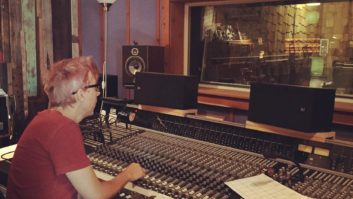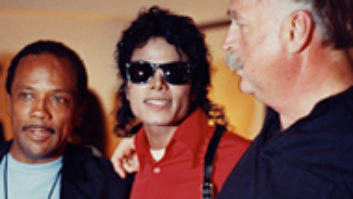A Second Installment From the Mix Archives
Learn more about the legend in excerpts from an interview by Larry Blakey, from the August 1983 issue of Mix.
On his adventures working at WDAN in Danville, Illinois:
“One January evening I noticed that one of the tower lights was out. The company policy was to hire guy from the power company to climb this 312-foot tower and replace the lights. Three hundred twelve feet was pretty high in January, especially with the snow and wind., but knowing they paid $25 to change the lights, I decided I would do this and be a wealthy hero. It was a very scary experience: I climbed the tower carrying a gunny sack with two 1,500-watt lights and when I got to the top and braced myself, the tower was swaying back and forth like an upside down pendulum. But I did get the bulbs changed, and it took me almost two hours to climb back down the tower. I had forgotten to tell anyone at the studio that I was leaving the transmitter and the phone had been ringing off the wall. The chief engineer was waiting for me and said, ‘guess what? You’re fired!’ after our tempers had quieted down, I found out that they took a dim view of station personnel changing the power lights. By the next morning I had succeeded in getting my job back.”
On mine detectors and the military:
“[Mine detectors used by the signal Corps] had a search coil on a large broomstick, and a very heavy battery pack with large vacuum tubes. I conceived that it might be possible to use hearing aid tubes and more advanced bridge circuits as a way to miniaturize the mine detector. I started working on this project in my spare time. I had talked at length with the chief signal officer of the 6th Service Command about the prospects of miniaturizing the mine detector and shortly thereafter had a visit from a couple of men in civilian clothes, whom I later found out were members of the Secret Service. They asked a lot of questions, like how small the device should be made. They told me that they were interested in making a personal gun detector that could be worn in the sleeve of a dress suit and could detect a small caliber handgun…”
On early attempts to build audio gear:
“Recording …was a labor of love. I had built a belt drive turntable, my first attempt at trying to put together some professional recording equipment. The mixers I used were purchased from Gates Radio, portable broadcaster mixers called the Gates Dynamote. The mics were RCA 44Bs (that was before the 44BX), the RCA 74B (which looked like the 44BX but measured only two-thirds the size), the Western Electric 633 ‘Salt Shaker,’ Western Electric 630 ‘Eight Ball’ and the Western Electric 639 ‘Bird Cage.’ It was surprising how well we did, considering the equipment we had to work with.”







